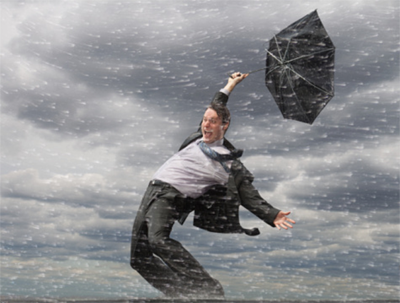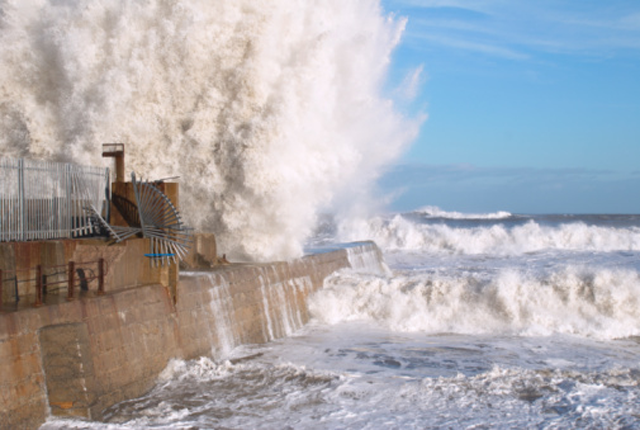Nov 01, 2025
Nov 01, 2025
 Compared to olden times the occurrence of natural disasters is much less in terms of numbers and intensity, but with human settlements at almost every nook and corner, the need for better management has become acute. Had a pre-disaster management exercise been done in the past hundreds of lives could have been saved! Take for example earthquakes. Post-disaster damage studies act like post mortem and help in knowing a lot about the pulse of the earth. But there are certain signs which are coming to the notice of scientists now which might help in taking precautionary measures as a pre-disaster mitigation plan! Compared to olden times the occurrence of natural disasters is much less in terms of numbers and intensity, but with human settlements at almost every nook and corner, the need for better management has become acute. Had a pre-disaster management exercise been done in the past hundreds of lives could have been saved! Take for example earthquakes. Post-disaster damage studies act like post mortem and help in knowing a lot about the pulse of the earth. But there are certain signs which are coming to the notice of scientists now which might help in taking precautionary measures as a pre-disaster mitigation plan! In the recent years The Bhuj Earthquake of 26 January 2001, Sumatran earthquake of December 2004 leading to destructive Tsunami which rocked the coastal towns of Indian Peninsula, Kashmir (Pakistan) earthquake of 2005 and Sichuan (China) earthquake of 2008 were some of worst natural disasters. More than half a million lives were lost in these mishaps. Earthquakes are like Electro-Cardiograms (ECG) of the Earth and each earthquake has a different signature-like a different ECG of a heart patient. The cardiologist examines the ECG and prescribes medicines or further tests to save the life of the patient. Likewise it is the duty of the seismologist to study the Earth’s ECG and prescribe safety measures. Just to site an example, the Uttarkashi earthquake of October 1991 razed to ground nearly 100000 houses and killed 788 people (Uttaranchal Developing on Shaky Ground- boloji.com 1 June 2006). But the damage was not restricted to the houses alone. The earthquake had triggered a large number of landslides, which blocked the roads and snapped the communication and power lines. An earthquake can not be predicted but detailed post-earthquake damage studies are important for creating a data base that helps in forecasting at least what to expect in a particular type of earthquake. For example the Uttarkashi earthquake gave information that all structures/houses that can be affected by a seismogenic earthquake must be relocated/strengthened/fortified. Amongst such structures communication and electricity transmission towers and school and hospital buildings are most vital. Such buildings are the places where either injured are hospitalized or school buildings are used as temporary shelters during a hazard emergency. In addition in case the earthquake occurs during the school hours, as it did in case of Sichuan earthquake the loss of lives could be stupendous if the structures are weak or wrongly located. A simple warning in earthquake prone areas in California says ‘Do not keep curios and things on mantle shelf which can fall off during a shaking.’ Normally during ‘peace times’ (when there is no earthquake) such warnings sound ridiculous, but you realize the significance when there is a sudden shaking and a small brass curio falling down from a height of five feet is enough to cause serious injury on a person under it. Tsunami, earthquake, landslide and flood are some of the natural disasters that take a heavy toll of life. Amongst these an earthquake is the biggest killer, because it catches the population unaware. Denser the population, higher is the chances of more causality.  For example, the Himalayan states of Himachal Pradesh and Uttarakhand are vulnerable at present for an earthquake of more than 7.5 magnitudes in Mercalli scale. This scale is based upon how people perceive the magnitude of the earthquake and how it is felt. For example an earthquake of magnitude 7 is considered as Very Strong and the description reads as: ‘Difficult to stand; furniture broken; damage negligible in building of good design and construction; slight to moderate in well-built ordinary structures; considerable damage in poorly built or badly designed structures; some chimneys broken. Noticed by people driving motor cars.’ Unfortunately the earthquake that is anticipated in the areas mentioned, on the basis of subsurface stresses is of a magnitude still higher than the one described here. Majority of the houses in these states are poorly built. The towns in these states are now densely populated. The probability index of an earthquake in these areas is of the order 0.986. In the eventuality of an earthquake damage in the epicentral areas in these states would be of an astronomical order. Not only the Himalayan states but even the capital Delhi is very much vulnerable for a very strong earthquake. Researchers predict that all buildings taller than 17 m in Delhi National Capital Region (NCR) could suffer heavy damage. Likewise now there is information availability about the ground shaking and possible damages in Dehradun, Kolkata, Jabalpur and Delhi. Data of anticipated ground shaking is being collected for other major earthquake prone towns in the country. Although the seismologists do not agree with suggestions about pre-earthquake warnings, but some of the post earthquake investigations have revealed interesting facts. For example, before Sumatran earthquake the sea surface temperatures (SST) had risen by 5 to 7 degrees Celsius for about a week or so before the occurrence of earthquake. With the advanced technology now it is possible to get data on SST and land surface temperatures on hourly basis from satellite pictures. Studies have revealed that the temperatures of the epicentral region during Kashmir earthquake had risen by 8 to 10 degrees Celsius above normal temperatures a day before the earthquake. This further confirms the observation of some of the scientists that temperatures in the epicentral region considerably rise before the occurrence of an earthquake. More and more data is pouring in now and the seismologists after turning the pages of information on post earthquake damage studies found that Rayleigh wave (R wave) damage from large magnitude earthquakes has a peculiarity. In 1985 during an earthquake in Mexico city an earthquake of 8.0 magnitude occurred with epicentre at a distance of about 550 km. It was found that all structures above the height of 17 m were heavily damaged, while structures of less height remained intact. This observation was further refined after the Bhuj earthquake of 2001. The R wave damage in Gujarat in areas beyond 150 km from the epicenter and less than 550 km affected structures more than 17 m high, and tall buildings in Ahmedabad about 320 km from the epicenter suffered heavy damage. Similarly during the Kashmir (Pakistan) earthquake a ten story building in Islamabad was collapsed completely. Similarly during an earthquake of 6.25 magnitude at Bhutan in 2009 a tall building at Guwahati tilted by about 5 degree. This was located about 150 km from the epicenter. The building might have collapsed if the earthquake was of a magnitude 7 or above. These were not just coincidences, but damages caused by the R waves. The possible or rather probable epicenters of future earthquake in the Himalayas are as per the seismologists at locations which make tall structures at Delhi, Noida, Gurgaon, Ghaziabad, Jaipur and Agra are highly vulnerable. The Bureau of Indian Standards revised the seismic code after the Bhuj Earthquake. The finding of relation of R waves and damage to buildings of more than certain heights therefore calls for a revision of the code. Knowing about the possible damages in a future earthquake is one part of the story. In order to complete the picture the authorities must introduce strict norms of building designs and construction. The authorities responsible for clearing the maps might ‘overlook’ the irregularities in designs but the house owners/builders/developers must remember that the nature does not spare any one. But nature sometimes does have telltale signs prior to an earthquake. These precursors though not yet accepted by the seismologists are often sure shot indicators of the impending disaster. In China before the last major earthquake it was seen by the people that frogs began to leave the ponds hours before the earthquake. Present day science of earthquakes may not accept it as a fact, but ‘Brihadsamhita’ of Varahmihira also has record of similar incidents say some of the researchers. Apart from animals even abnormal human behavior prior to major earthquake too has been recorded. It is reported that prior to Latur, Bhuj and Andaman earthquakes there was a sudden spurt in the rate of deliveries by five to seven times than daily average. Yet another phenomenon noticed by radio buffs is that prior to an earthquake Radio transmission gets affected. A before the Haiti earthquake on 12 January, 2010 radio communication was heavily affected and at times even blocked. This phenomenon is known as ‘Seismo-electromagnetic effect’. Our Disaster managers could take a note of these phenomenons some scientifically proven and some yet to be proven and make use of such information in smooth pre-disaster management. Of course there is another angle to this story. If the disaster management teams start taking precautionary measures it can cause panic in the public. In panic humans too behave weird. Therefore public awareness is a must and constant programmes in the television, radio and news reports can help in making the masses aware about the earthquake hazard and also learn dos and don’ts. Involving school children in such awareness programmes will not help the present generation but also create an aware and hazard educated future generation. |
04-Aug-2010
More by : V. K. Joshi (Bijji)

|
Details of damages caused by Natural disasters by V K Joshi are thought provoking and the measures to be adopted to over come the effects of havocs are really looking to be useful for the future protection of properties and lives all over the world! |

|
Details of damages caused by Natural disasters by V K Joshi are thought provoking and the measures to be adopted to over come the effects of havocs are really looking to be useful for the future protection of properties and lives all over the world! |

|
Thank you taramesh. Except earthquakes all other natural disasters can be predicted and forecasts can be made. But we are used to post disaster relief, I do not understand why. Lack of public awareness is another factor. Everyone knows well that a house on the river bank will be flood prone, but no one seems bother and maps for such dwellings are cleared. Unless the society is alert nothing can be achieved. |

|
Thank you taramesh. Except earthquakes all other natural disasters can be predicted and forecasts can be made. But we are used to post disaster relief, I do not understand why. Lack of public awareness is another factor. Everyone knows well that a house on the river bank will be flood prone, but no one seems bother and maps for such dwellings are cleared. Unless the society is alert nothing can be achieved. |

|
Details of damages caused by Natural disasters by V K Joshi are thought provoking and the measures to be adopted to over come the effects of havocs are really looking to be useful for the future protection of properties and lives all over the world! |